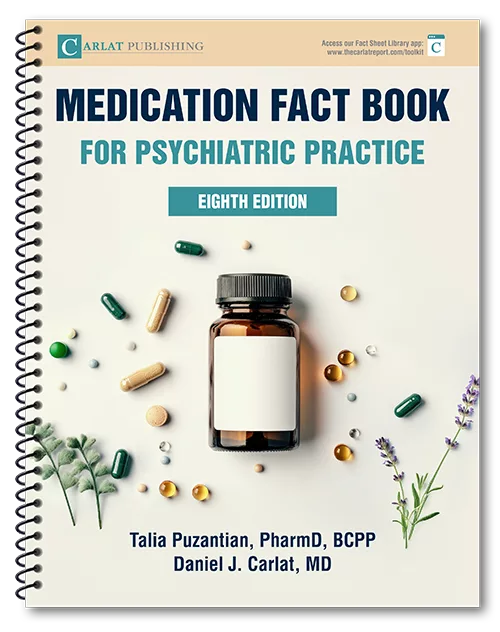Medication Fact Book For Psychiatric Practice, Fourth Edition (2018)
PDF Access and CME Post-Test
Dr. Puzantian and Dr. Carlat have disclosed that they has no relevant relationships or financial interests in any commercial company pertaining to this educational activity.

Downloading your PDF and eBook copies and complete the CME Post-Test for The Medication Fact Book for Psychiatric Practice, Fourth Edition (2018).
Download the PDF version.
Click here to download your PDF copy. Depending on your browser the book may open in a new window, tab, or appear in your downloads folder. This PDF file is available to you as a purchaser but it may not be produced or distributed without permission from Carlat Publishing, LLC.
Download for Kindle readers.
- For your phone or tablet: Open this page using a browser on your phone or tablet device. Then click here to download the .mobi file. When the page loads choose the blue. Then access the file by opening your Kindle app. It will appear as an option in your library.
- For your Kindle reader: Add the book to your Amazon Kindle device using your desktop, laptop, or mobile device by clicking here to download the .mobi file. Transfer it to your Kindle using the connective cable to connect the device to your desktop or laptop and dragging the .mobi file from your download folder to the device's storage. Email the file as attachment directly to your device using these instructions from Amazon.
Download for Nook and other eReader devices.
For your phone or tablet: Open this page using a browser on your phone or tablet device. Then click here to download the .epub file. When the page loads choose the blue "Download" button to transfer the file to your device. Access the file by opening your eReader app of choice. It will appear as an option in your library.
Online Updates:
Aripiprazole lauroxil (Aristada) long acting injection
The FDA approved Aristada Initio for the single-dose, 1-day initiation of aripiprazole lauroxil (Aristada) long acting injection for schizophrenia. How is this different from the currently available formulation of Aristada? With regular Aristada, you give an injection, but then your patient must take aripiprazole pills for 21 days while the blood levels of the injectable version gradually increase. With Initio, patients just take one 30 mg oral dose at the same time as first injection and get to acceptable blood levels by day four. The one-time Initio dose is then followed by any of the usual Aristada dosing regimens (441 mg, 662 mg, or 882 mg monthly; or 882 mg every six weeks; or 1064 mg every two months), given either on the same day as Aristada Initio or up to 10 days after. Just be sure to avoid giving both doses into the same deltoid or gluteal muscle.
Buprenorphine / naloxone (Suboxone) sublingual film
Suboxone sublingual film is now available in a generic formulation. This generic is in addition to buprenorphine (monoformulated) generic 2 mg and 8 mg sublingual tablets and buprenorphine/naloxone generic 2/0.5 mg and 8/2 mg sublingual tablets. Buccal film formulation (Bunavail) remains brand only
Intravenous Injection Effective for Postpartum Depression
The FDA has approved brexanolone (Zulresso), a neurosteroid chemical identical to endogenous allopregnanolone, as an intravenous injection to treat postpartum depression (PPD) in women. Its efficacy in PPD is thought to be related to its modulation of gamma-aminobutyric acid A (GABAA) since endogenous allopregnalonone levels rise during pregnancy and then fall abruptly after childbirth. Efficacy was demonstrated in two multicenter, randomized, double-blind, placebo-controlled, 4-week trials of women (ages 18-45) with moderate to severe PPD who had onset of symptoms in the last trimester or within 4 weeks of delivery. A significantly higher percentage of patients receiving a 60-hour continuous intravenous infusion of brexanolone achieved remission than those receiving placebo. The most common side effects were sedation, somnolence, dry mouth, loss of consciousness and flushing. Its use is restricted to patients and healthcare facilities which are enrolled in the Zulresso REMS program which requires that a healthcare provider monitor for hypoxia using continuous pulse oximetry with an alarm for the duration of its 60-hour infusion. This novel, fast-acting option could be a big breakthrough for severe depression in PPD but the lengthy infusion in a healthcare setting, potential for severe reactions and associated need for close monitoring, high cost ($34,000 for the drug alone, plus costs associated with providers and healthcare facility), and lack of follow up data beyond 30 days will limit its utility.
Lofexidine (Lucemyra) new fact sheet
Download Lofexidine PDF fact sheet here.
Lurasidone (Latuda) new indicaton
Lurasidone (Latuda) has a new FDA indication: bipolar depression in kids and teens between the ages of 10 and 17. Previously, the FDA had approved lurasidone for treating schizophrenia in adults and adolescents 13-17 and bipolar depression in adults.
This newest indication is based on results of a 6-week randomized double blind placebo controlled study of 347 kids receiving lurasidone 20-80 mg/day or placebo. Lurasidone treated patients had a statistically significant larger improvement in symptoms of bipolar depression with an effect size of 0.45 (as measured by Children’s Depression Rating Scale, Revised). The most common side effects in this study were nausea (16%), weight gain (7%) and insomnia (5%).
It’s important to note a few things: this is the first and only study of lurasidone for kids with bipolar depression, longer term use has not been studied, and lurasidone’s efficacy in bipolar mania (in kids or adults) has not been established.
Nasal Esketamine a New Option for Treatment Resistant Depression
The FDA gave a “fast track and breakthrough therapy” approval of a nasal spray formulation of esketamine (marketed as Spravato), to be used in conjunction with a conventional antidepressant (AD), for patients with treatment-resistant depression (TRD). Esketamine (ESK) is the s-enantiomer of the anesthetic agent ketamine (Ketalar) approved in 1970, works as an antagonist at N-methyl D-aspartate (NMDA) receptors, and is classified as a CIII scheduled controlled substance. Download Esketamine PDF fact sheet here.
Pimavanserin (Nuplazid) safety
Pimavanserin (Nuplazid) is the only drug approved to treat hallucinations and delusions associated with Parkinson’s disease (PD) psychosis. Alarmingly, hundreds of post-marketing deaths in PD patients taking pimavanserin have been reported. The Institute for Safe Medication Practices reviewed the 244 death reports in the first 10 months after the drug was approved and found the death rate in patients taking pimavanserin was 5.3% compared to 0.5% in those not taking it. So far, the FDA has tracked more than 700 death reports, and after its own review decided that since it’s the only effective agent for PD psychosis, its benefits outweigh this risk. It’s important to note that the deaths reported typically involved individuals with high mortality rate: elderly patients, with advanced-stage Parkinson’s disease, numerous medical conditions, and often taking other medications which could contribute to increased risk of death.
Solriamfetol, A New Wake Promoting Agent, Approved for Sedation
Solriamfetol (Sunosi), a new dopamine and norepinephrine reuptake inhibitor (DNRI), has been approved by the FDA as a wake promoting agent to treat excessive daytime sedation due to narcolepsy or obstructive sleep apnea. Approval was based on the findings of four studies of over 900 adults with improvement that was maintained for up to 50 weeks. Side effects include anxiety, irritability, insomnia, headache, nausea and low appetite. At higher doses, it may raise blood pressure and pulse. There’s an abuse potential with higher than the recommended dose of 37.5-150 mg/day and the DEA is considering how it will schedule it (possibly a Schedule IV similar to Provigil and Nuvigil).


Newsletters
Please see our Terms and Conditions, Privacy Policy, Subscription Agreement, Use of Cookies, and Hardware/Software Requirements to view our website.
© 2026 Carlat Publishing, LLC and Affiliates, All Rights Reserved.

_-The-Breakthrough-Antipsychotic-That-Could-Change-Everything.webp?t=1729528747)



